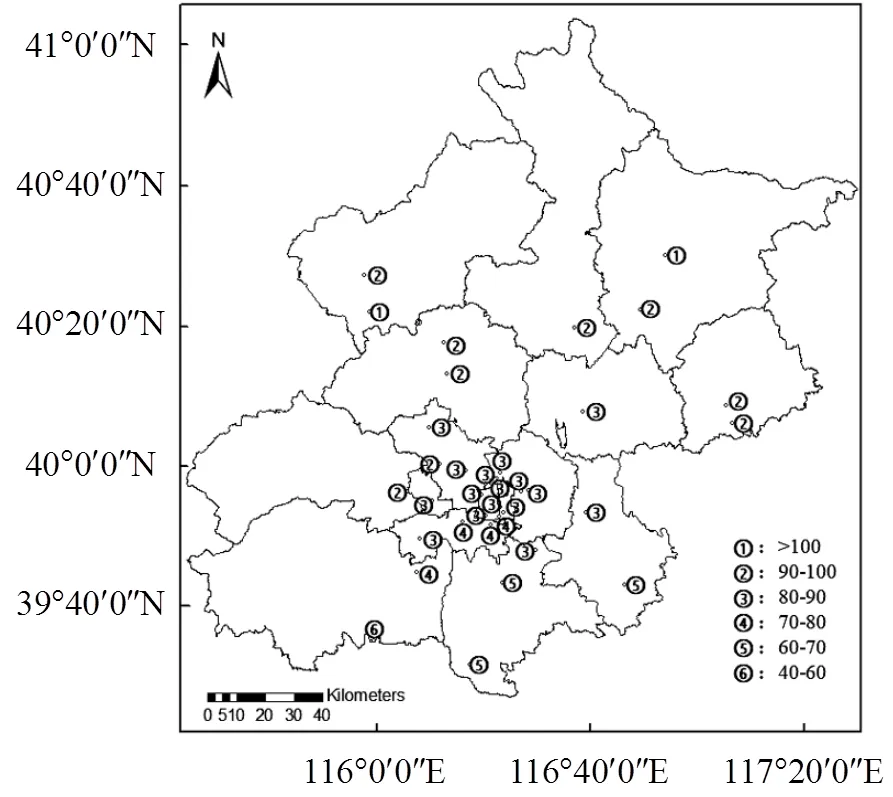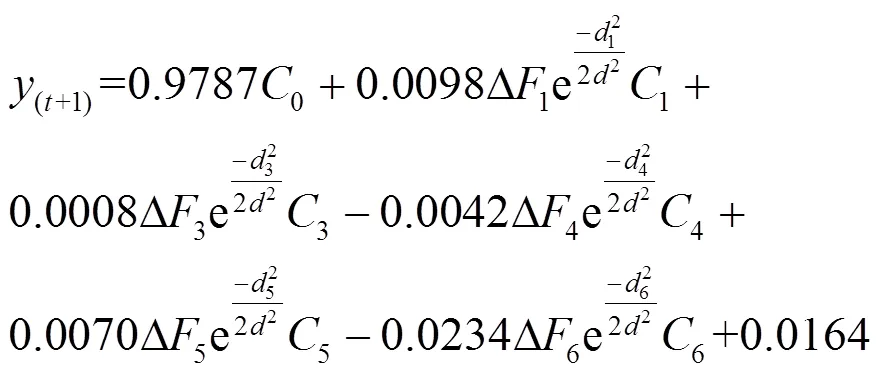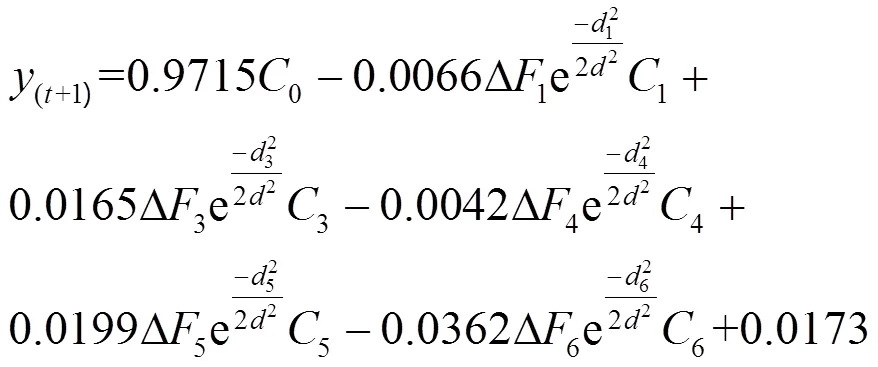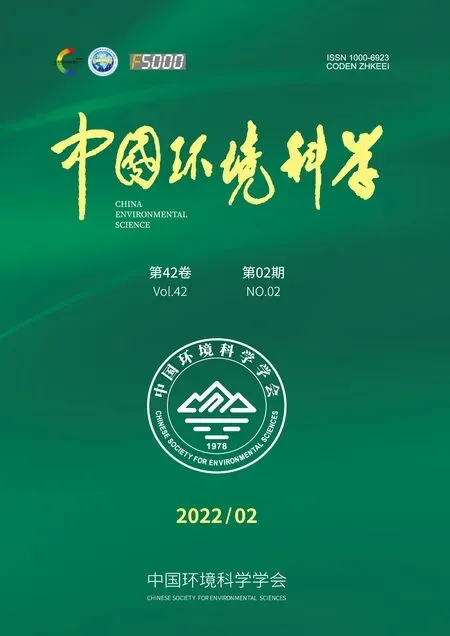城市内部尺度PM2.5传输关联方法研究—以北京市为例
尹 浩,胡冬梅,闫雨龙,彭 林,王 凯,张可可,邓萌杰
城市内部尺度PM2.5传输关联方法研究—以北京市为例
尹 浩,胡冬梅*,闫雨龙,彭 林,王 凯,张可可,邓萌杰
(华北电力大学环境科学与工程学院,资源环境系统优化教育部重点实验室,北京 102206)
基于数据驱动思想,以城市内部环境空气质量监测站点为研究对象,建立了目标站点与周边站点间PM2.5浓度、风向、风速、欧几里得距离等参数的多元线性关联回归模型,使用梯度下降算法学习得到各参数权重系数,计算得出周边站点对目标站点PM2.5传输贡献,并评估了模型的可行性.以北京市丰台花园(FT)为目标站点的应用研究结果显示,2016年FT站点PM2.5浓度为82μg/m³,周边站点大兴(DX)、房山(FS)、亦庄(YZ)、东四环(DS)、古城(GC)和万柳(WL)浓度分别为93,82,80,79,77,71μg/m³; FT站点PM2.5浓度与上一时刻周边站点WL、GC、DX、YZ的相关性分别为0.634、0.631、0.608和0.601,显示其对FT站点PM2.5污染传输显著;建立的4个季节关联回归模型RMSE值分别为13.22、11.74、12.51和13.22, PM2.5模拟浓度与监测浓度变化趋势一致,验证了模型的可行性;WL、DX、YZ、GC分别是对应春、夏、秋、冬4个季节对FT 站点PM2.5污染传输贡献较大的站点,其贡献值分别为1.61%、1.71%、2.20%和8.57%.该模型解析的结果可为北京市未来城市规划、建设提供依据,提出的PM2.5传输多元线性关联回归方法同样可用来解析其他城市内部尺度PM2.5传输关联,为挖掘城市内部PM2.5传输路径、精准溯源提供基础.
城市内部尺度;PM2.5;多元线性关联回归;传输贡献
研究表明,城市某地区PM2.5浓度受自身上一时刻污染物浓度积累、周边区域浓度、气象条件和欧几里得距离等多种因素影响[1-6], PM2.5浓度预测需综合考虑众多要素. 目前,对于城市PM2.5污染传输研究,主要分为数值分析、气象场分析和统计分析3大类,其中Models-3/CMAQ[7]、WRF-Chem[8]和轨迹分析法[9]运用相对较多.薛文博等[10]利用CAMx空气质量模型的颗粒物来源追踪技术(PSAT)定量模拟得到全国PM2.5跨区域输送规律; 齐孟姚[11]利用WRF-Chem模拟并得到了河北南部城市边界的PM2.5通量,并由此推导出模拟期间PM2.5的主要传输路线及通道区域;任传斌等[12]利用HYSPLIT后向轨迹模型分析了北京市不同输送途径的空间特征及其对北京城区PM2.5聚集的贡献;余创等[13]利用气流后向轨迹聚类分析法研究了银川市PM2.5的输送路径及潜在源分布.但此类模型主要适用于大尺度城市间的污染传输研究,运用在小尺度传输研究中可能会出现流场解析不准确、化学机制不确定性大等因素导致结果存在较大不确定性问题[14].
本文综合考虑环境空气质量监测站点污染物浓度、风向、风速、欧几里得距离等影响污染传输的时空因素特征,建立基于时空传输特征的城市内部尺度PM2.5传输关联研究方法.以北京市丰台花园站点为目标站点,以其周边相关联的6个站点为传输变量,研究不同季节6个关联站点对丰台花园站点PM2.5的污染传输贡献,旨在为挖掘城市内部PM2.5污染传输路径、精准溯源提供基础.
1 数据来源及方法建立
1.1 数据来源

图1 7个空气质量站点空间分布
选取北京市2016年7个空气质量站点PM2.5小时浓度数据,7个气象监测站点的风向、风速小时数据以及站点经纬度数据.其中环境空气PM2.5浓度数据来源于北京市环境监测中心站实时数据(http://zx.bjmemc.com.cn),共计69656条.气象数据来源于国家气象科学数据中心(http://data.cma.cn/),共计122990条,站点经纬度数据来源于高德地图.对于PM2.5浓度、气象数据中检测到的异常、缺失值采用基于时间序列的拉格朗日插值法填充处理[15].
考虑北京市PM2.5浓度南高北低特征、站点空间分布特征以及目标站点可能受周边站点影响程度大小,选取北京市南部的、周边关联站点数量较多且PM2.5浓度相对较高的丰台花园站点(FT)为目标站点,探讨其周边6个相关站点对丰台花园站点PM2.5时空传输贡献.6个站点包括万柳(WL)、古城(GC)、房山(FS)、大兴(DX)、亦庄(YZ)和东四环(DS),涵盖了北京市朝阳区、海淀区、大兴区、丰台区、石景山区和房山区6个区域,空间分布如图1所示.
1.2 方法研究
城市内部PM2.5污染传输受浓度梯度、气象条件、站点间欧几里得距离等多种因素共同制约[16-19].因此,综合考虑监测站点污染物浓度、风向、风速、欧几里得距离等时空因素特征,定义目标站点1时刻PM2.5浓度,如公式(1):





式中:w为扩散系数;F()为时刻站点间的风力系数值;为2个空气质量监测站连线方向与风向之间的夹角;为污染物可以进行传输的最大距离(km).

图2 站点间风力系数示意








图3 夹角q示意图及风向十六方位


1.2.5 模型结果误差计算方法 为定量评估模型的计算准确度,采用均方根误差(RMSE)对模型进行定量评估[27].
1.2.6 时空传输来源计算方法 根据建立的时空传输关联模型,定义时空传输贡献率,如公式(10).
式中:C分别为关联站点时刻PM2.5浓度(μg/m3);为对应影响权重;DF为空气质量监测站点之间时刻的风力系数差值;d为空气质量监测站点之间的欧几里得距离(km);为污染传输的最大距离(km);(t+1)为模型计算目标站点浓度值(μg/m³).
2 结果与讨论
2.1 环境空气质量数据时空特征分析

图4 北京市35空气质量站点PM2.5浓度空间分布
北京市共35个环境空气质量监测站点,各站点PM2.5浓度整体呈南高北低的空间分布特征[28],如图4所示,南部站点更易受其周边高PM2.5浓度站点影响,站点间PM2.5输送贡献也更为明显[29-30].2016年各站点PM2.5年均浓度分别为DX 93μg/m3、FS 82μg/m3、FT 81μg/m3、YZ 80μg/m3、DS 79μg/m3、GC 77μg/m3和WL 71μg/m3.
从图5中可以看出,7个站点PM2.5峰值浓度随时间推移而逐步升高,相邻站点间PM2.5浓度变化趋势具有明显协同性.

图5 2016年一次空气重污染过程时刻各站点PM2.5浓度时间序列

图6 关联站点与目标站点PM2.5浓度相关性
为定量解析任意关联站点与目标站点PM2.5浓度的相关性,基于最大信息系数理论[31],计算各关联站点时刻PM2.5浓度与目标站点1时刻PM2.5浓度的MIC值.从图6可以看出,WL(t)、GC(t)、DX(t)、YZ(t)与FT(t+1)的MIC值相对较大,分别为0.6340、0.6305、0.6079和0.6007,表明站点之间的关联性较大,PM2.5传输贡献显著.探究其可能的原因,WL、GC与目标站点FT直线距离相对较小,分别为13.81和9.89km,传输相对容易且传输中损耗较小,故WL(t)、GC(t)与FT(t+1)关联性较大;DX、YZ与FT的传输距离优势相对较小,但DX、YZ位于FT的东南方向,且2016年北京市的主导风向为东南风,风频为28.39%,气象条件有利于传输,故DX(t)、YZ(t)与FT(t+1)关联性较大.
2.2 时空传输关联模型结果解析
城市内部大气污染物的传输具有复杂多变的动态特征[32-33],季节变化显著[34].本文基于2016年7个站点PM2.5小时浓度数据、小时气象数据、站点空间位置数据,应用建立的时空传输关联模型分别得到2016年4个季节的目标站点PM2.5浓度,如式(12)~式(15).
2016年春季结果:

2016年夏季结果:

2016年秋季结果:

2016年冬季结果:

以FT为目标站点的各个季节关联回归模型结果显示, 4个季节PM2.5模拟浓度与监测浓度的RMSE值分别为13.22、11.74、12.51和13.22,模型准确性较高.分别随机选取4个季节部分历史时刻数据对模型进行验证,模型模拟值与实际监测浓度变化趋势一致,进一步验证了模型的准确性,如图7所示.该模型解析的结果可为北京市未来城市规划、建设提供依据.提出的PM2.5传输多元线性关联回归模型方法同样可用来解析其他城市内部尺度PM2.5传输关联.

图7 2016年4个季节模型结果与实际数据对比
2.3 应用时空传输关联模型解析PM2.5传输特征
应用时空传输关联模型解析2016年4个季节PM2.5传输特征,如图8所示.春季周边传输对FT的贡献率为2.56%,其中WL、YZ贡献相对较大,分别为1.61%和0.81%;夏季周边传输对FT的贡献率为3.47%,其中DX、WL贡献相对较大,分别为1.71%和1.69%;秋季周边传输对FT的贡献率为4.08%,其中YZ、WL贡献相对较大,分别为2.20%和1.77%;冬季周边传输对FT的贡献率为8.98%,其中GC贡献最大,为8.57%;DS全年对FT贡献最小.综合比较发现,4个季节中周边站点对FT的贡献由大到小分别为冬季>秋季>春季>夏季;WL在春、夏、秋3个季节对FT贡献率均排在前3位,冬季对FT基本无贡献;GC在冬季对FT贡献明显,春、夏、秋3个季节基本无贡献;DX在夏季对FT传输相对较多,春、秋、冬3个季节相对较少;YZ在春、秋季对FT贡献相对较多,夏、冬季相对较少.分析PM2.5传输结果呈现的站点差异、季节差异原因知,不同季节的气象条件、污染物浓度各有区别,不同站点与目标站点的欧几里得距离、风力差值大小不同,会对PM2.5传输产生不同程度影响.


图8 2016年4个季节周边站点对FT传输贡献
3 结论
3.1 基于数据驱动思想,以城市内部环境空气质量监测站点为研究对象,提出并建立了目标站点与周边站点间PM2.5浓度、风向、风速、欧几里得距离等参数的多元线性关联回归模型,使用梯度下降算法学习得到各参数权重系数,计算得到周边站点对目标站点PM2.5传输贡献.
3.2 2016年FT站点PM2.5浓度为82μg/m3,周边站点DX、FS、YZ、DS、GC和WL浓度分别为93, 82,80,79,77,71μg/m3. FT站点PM2.5浓度与上一时刻周边站点WL、GC、DX、YZ的MIC值分别为0.634、0.631、0.608和0.601.
3.3 建立了以FT为目标站点的2016不同季节关联回归模型, PM2.5模拟浓度与实际监测浓度变化趋势一致,4个季节模型的RMSE值分别为13.22、11.74、12.51和13.22.
3.4 WL,DX,YZ,GC分别是对应春、夏、秋、冬4个季节对FT 站点PM2.5污染传输贡献较大的站点,其贡献值分别为1.61%,1.71%,2.20%和8.57%.
[1] Bove M C, Brotto P, Cassola F, et al. An integrated PM2.5source apportionment study: positive matrix factorisation vs. the chemical transport model CAMx [J]. Atmospheric Environment, 2014,94:274-286.
[2] Sulaymon I D, Zhang Y, Hu J, et al. Evaluation of regional transport of PM2.5during severe atmospheric pollution episodes in the Western Yangtze River Delta, China [J]. Journal of Environmental Management, 2021,293(18):112827.
[3] 邓萌杰,闫雨龙,胡冬梅,等.长治市沙尘天气污染特征及传输路径解析[J]. 中国环境科学, 2020,40(10):4275-4283.
Deng M J, Yan Y L, Hu D M, et al. Analysis of dust weather pollution characteristics and transmission paths in Changzhi, China [J]. China Environmental Science, 2020,40(10):4275-4283.
[4] Li R, Wang J, Xue K, et al. Spatial and temporal distribution characteristics and influencing factors analysis of particulate matter pollution in Jinan City [J]. Air Quality Atmosphere & Health, 2021,14:1267-1278.
[5] 吴健生,廖 星,彭 建,等.重庆市PM2.5浓度空间分异模拟及影响因子[J]. 环境科学, 2015,36(3):759-767.
Wu J S, Liao X, Peng J, et al. Simulation and influencing factors of spatial distribution of PM2.5concentrations in Chongqing [J]. Environmental Science, 2015,36(3):759-767.
[6] Hou X, Zhu B, Kumar K R, et al. Inter-annual variability in fine particulate matter pollution over China during 2013~2018: Role of meteorology [J]. Atmospheric Environment, 2019,214:116842.
[7] Solazzo E, Hogrefe C, Colette A, et al. Advanced error diagnostics of the CMAQ and Chimere modelling systems within the AQMEII3 model evaluation framework [J]. Atmospheric Chemistry and Physics, 2017,17(17):10435-10465.
[8] 周广强,谢 英,吴剑斌,等.基于WRF-Chem模式的华东区域PM2.5预报及偏差原因[J]. 中国环境科学, 2016,36(8):2251-2259.
Zhou G Q, Xie Y, Wu J B, et al. Based on WRF-Chem model, the PM2.5forecast and deviation reason in East China region [J]. Chinese Environmental Science, 2016,36(8):2251-2259.
[9] Qin Y G, Yi C, Dong G L, et al. Investigating the influence of meteorological factors on particulate matters: A case study based on path analysis [J]. Energy and Environment, 2019,31(3):479-491.
[10] 薛文博,付 飞,王金南,等.中国PM2.5跨区域传输特征数值模拟研究[J]. 中国环境科学, 2014,34(6):1361-1368.
Xue W B, Fu F, Wang J N, et al. Numerical study on the characteristics of regional transport of PM2.5in China [J]. China Environmental Science, 2014,34(6):1361-1368.
[11] 齐孟姚.应用WRF-Chem模型解析河北南部城市PM2.5来源及传输路径[D]. 邯郸:河北工程大学, 2020.
Qing M Y. Source apportionment and inter-city transport of PM2.5in southern Hebei cities using WRF-Chem [D]. Handan: Hebei University of Engineering, 2020.
[12] 任传斌,吴立新,张媛媛,等.北京城区PM2.5输送途径与潜在源区贡献的四季差异分析[J]. 中国环境科学, 2016,36(9):2591-2598.
Ren C B, Wu L X, Zhang Y Y, et al. Analyze to the seasonal differences of transport pathways and potential source-zones of Beijing Urban PM2.5[J]. China Environmental Science, 2016,36(9): 2591-2598.
[13] 余 创,张玉秀,陈 伟.银川市PM2.5的输送路径及潜在源解析[J]. 中国环境科学, 2021,41(7):3055-3065.
Yu C, Zhang Y X, Chen W. The transport pathways and potential source regions of PM2.5in Yinchuan, China [J]. China Environmental Science, 2021,41(7):3055-3065.
[14] 吕宗璞.基于CMAQ模型的京津冀地区污染物传输路径和输送通道研究[D]. 石家庄:河北科技大学, 2019.
Lv Z P. Study on pollutant transmission path and conveying channel in Beijing-Tianjin-Hebei area based on CMAQ model [D]. Shijiazhuang: Hebei University of Science and Technology, 2019.
[15] Resende D C O D, Santana D L D, Fábio Manoel Frana Lobato. Time Series Imputation Using Genetic Programming and Lagrange Interpolation [Z]. 2016 5th Brazilian Conference on Intelligent Systems (BRACIS). IEEE, 2017.
[16] Wang, Yu F, Hai Y, et al. A weighted higher-order network analysis of fine particulate matter PM2.5transport in Yangtze River Delta [J]. Physica, A. Statistical Mechanics and its Applications, 2018,496:654-662.
[17] Zhao G, Huang G, He H, et al. Innovative Spatial-Temporal Network Modeling and Analysis Method of Air Quality [J]. IEEE Access, 2019,7:26241-26254.
[18] Qbadou M, Hajji M, Samadi A, et al. Improving the selection process of students in higher education based on data warehouse and data mining techniques [Z]. International Technology, Education and Development Conference, 2016.
[19] 柳萌萌,赵书良,韩玉辉,等.多尺度数据挖掘方法[J]. 软件学报, 2016,27(12):3030-3050.
Liu M M, Zhao S L, Han Y H, et al. Research on multi-scale data mining method [J]. Journal of Software, 2016,27(12):3030-3050.
[20] Wen H F, Dang Y M, Li L W. Short-term PM2.5concentration prediction by combining GNSS and meteorological factors [J]. IEEE Access, 2020,8:115202-115216.
[21] Zhao G, Huang G, HE H, et al. Mining key stations by constructing the air quality spatial-temporal propagation network [J]. IEEE Access, 2020,PP(99):97485-97502.
[22] 吴 瑶.区域大气污染物关键传播路径和重要节点挖掘方法研究[D]. 秦皇岛:燕山大学, 2018.
Wu Y. Research on key propagation path and important node mining method of regional air pollutants [D]. Qinhuangdao: Yanshan university, 2018.
[23] Liberti L, Lavor C, Maculan N, et al. Euclidean distance geometry and applications [J]. SIAM Review, 2012,56(1):3-69.
[24] Quentin M, Fabrice P, Jeng-antoine D. Stochastic multiple gradient descent algorithm [J]. European Journal of Operational Research, 2018,271(3):808-817.
[25] Lee G, Yi G, Youn B D. Special issue: a comprehensive study on enhanced optimization-based model calibration using gradient information [J]. Struct Multidiscip Optim., 2018,57(5):2005-2025.
[26] 王 丹.随机梯度下降算法研究[D]. 西安:西安建筑科技大学, 2020.
Wang D. A research of stochastic gradient descent algorithm [D]. Xi¢an: Xi'an University of Architecture and Technology, 2020.
[27] Chai T, Draxler R R. Root mean square error (RMSE) or mean absolute error (MAE)-Arguments against avoiding RMSE in the literature [J]. Geosci. Model Dev., 2014,7(3):1247-1250.
[28] 冯春莉,李润奎.基于土地利用回归模型的北京市2013~2019年大气污染时空变化分析[J]. 环境科学学报, 2021,41(4):1231-1238.
Feng C L, Li R K. Spatiotemporal variation analysis of air pollution from 2013 to 2019 in Beijing based on land use regression model [J]. Acta Scientiae Circumstantiae, 2021,41(4):1231-1238.
[29] 聂 滕,李 璇,王占山,等.APEC期间北京市PM2.5时空分布与过程分析[J]. 中国环境科学, 2016,36(2):349-355.
Nie T, Li X, Wang Z S, et al. Spatial and temporal distribution and process analysis of PM2.5pollution over Beijing during APEC [J]. China Environmental Science, 2016,36(2):349-355.
[30] 李珊珊,程念亮,徐 峻,等.2014年京津冀地区PM2.5浓度时空分布及来源模拟[J]. 中国环境科学, 2015,35(10):2908-2916.
Li S S, Chen N L, Xu J, et al. Spatial and temporal distrubions and source simulation of PM2.5in Beijing-Tianjin-Hebei region in 2014 [J]. China Environmental Science, 2015,35(10):2908-2916.
[31] Reshef D N, Reshef Y A, Finucane H K, et al. Detecting novel associations in large data sets [J]. Science, 2011,334(6062):1518-1524.
[32] Zhang H H, Hou Y G, Wu K J, et al. Study on Mechanism of Series-Flow of Pollutants between Consecutive Tunnels by Numerical Simulation [J]. Appl. Sci.-Basel., 2019,9(19):4125.
[33] Narasimhachar V, Poostindouz A, Gour G. Uncertainty, joint uncertainty, and the quantum uncertainty principle [J]. New Journal of Physics, 2016,18(3):033019.
[34] 卢 文,王红磊,朱 彬,等.南京江北2014~2016年PM2.5质量浓度分布特征及气象和传输影响因素分析[J]. 环境科学学报, 2019,39(4): 1039-1048.
Lv W, Wang H L, Zhu B, et al. Distribution characteristics of PM2.5mass concentration and their impacting factors including meteorology and transmission in North Suburb of Nanjing during 2014 to 2016 [J]. Acta Scientiae Circumstantiae, 2019,39(4):1039-1048.
[35] Zheng Z, Ren G, Hong W, et al. Relationship Between Fine-Particle Pollution and the Urban Heat Island in Beijing, China: Observational Evidence [J]. Boundary-Layer Meteorology, 2018,169(1):93-113.
Study on the transport correlation method of PM2.5at urban scale—taking Beijing as an example.
YIN Hao, HU Dong-mei*, YAN Yu-long, PENG Lin, WANG Kai, ZHANG Ke-ke, DENG Meng-jie
(Key Laboratory of Resources and Environmental System Optimization, Ministry of Education, College of Environmental Science and Engineering, North China Electric Power University, Beijing 102206, China)., 2022,42(2):550~556
Based on data driven, internal environment in city air quality monitoring sites as the research object, multiple linear correlation regression models were established for PM2.5concentration, wind direction, wind speed, Euclidean distance and other parameters between target stations and surrounding stations. The weight coefficients of each parameter were obtained by gradient descent algorithm, the PM2.5transmission contribution of surrounding stations to target stations was calculated and the feasibility of the model was evaluated. Taken Feng Tai Garden (FT) in Beijing as the target site, the results showed that the PM2.5concentration of FT site in 2016 was 82μg/m3, Da Xing (DX), Fang Shan (FS), Yi Zhuang (YZ), Dong Sihuan (DS), Gu Cheng (GC) and Wan Liu (WL) sites were93, 82, 80, 79, 77和71μg/m3. The correlation between PM2.5concentration of FT station and WL, GC, DX and YZ of surrounding stations at the last moment was 0.634, 0.631, 0.608 and 0.601, respectively, which indicates the significantly transmitted PM2.5pollution to FT station. RMSE values of the four seasonal correlation regression models were 13.22, 11.74, 12.51 and 13.22, respectively. The variation trend of PM2.5simulated concentration was consistent with that of the monitored concentration, which verified the feasibility of the model. WL, DX, YZ and GC were the stations that contribute more to PM2.5pollution transmission of FT station in spring, summer, autumn and winter respectively, and their contribution values were 1.61%, 1.71%, 2.20% and 8.57%, respectively. The model results can provide a basis for the future urban planning and construction of Beijing. The proposed multiple linear correlation regression method of PM2.5transmission can also be used to analyze the PM2.5transmission correlation of other urban scales, providing a basis for the mining of PM2.5transmission path and accurate traceability within the city.
intra-city scale;PM2.5;multiple linear correlation regression;transmission contribution
X513
A
1000-6923(2022)02-0550-07
尹 浩(1996-),男,河北张家口人,华北电力大学硕士研究生,主要从事大气污染控制研究.发表论文1篇.
2021-07-14
国家重点研发计划项目(2019YFC0214202,2019YFC0214203);国家自然科学基金资助项目(21976053);中央高校基本科研业务费专项资金资助项目(2019MS043)
* 责任作者, 讲师, huhu3057@ 163.com

